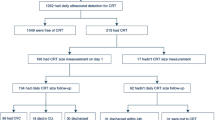Abstract
Background
Compared with consultative US performed by the radiology department, point-of-care US performed by non-radiology physicians can accurately diagnose deep venous thrombosis in adults.
Objective
In preparation for a multicenter randomized controlled trial, we determined the accuracy of point-of-care US in diagnosing central venous catheter-related thrombosis in critically ill children.
Materials and methods
Children <18 years old with a central venous catheter who were admitted to the intensive care unit were enrolled. Consultative and point-of-care compression ultrasounds with Doppler were done on the vein where the catheter was inserted within 24 h after insertion. Repeat US was obtained within 24 h of removal of the catheter. All images were centrally, blindly and independently adjudicated for thrombosis by a team of pediatric radiologists. Chance-corrected agreement between readings was calculated.
Results
From 84 children, 152 pairs of consultative and point-of-care ultrasounds were analyzed. A total of 38 (25.0%) consultative and 17 (11.2%) point-of-care ultrasounds were positive for thrombosis. The chance-corrected agreement between consultative and point-of-care ultrasounds was 0.17 (standard error: 0.07; P = 0.008). With consultative US as a reference, the sensitivity of point-of-care US was 28.1% (95% confidence interval: 13.7%-46.7%) with a specificity of 91.8% (95% confidence interval: 84.4%-96.4%). A catheter in the subclavian vein was associated with discordant readings (adjusted odds ratio: 4.00; 95% confidence interval: 1.45-13.94).
Conclusion
Point-of-care US, when performed by non-radiology physicians and centrally adjudicated by pediatric radiologists in the setting of a multicenter randomized controlled trial, may not accurately diagnose catheter-related thrombosis in critically ill children.






Similar content being viewed by others
References
Mitchell LG, Male C (2011) Outcome measures in interventional trials for prevention or treatment of venous thrombosis in the pediatric population. Semin Thromb Hemost 37:840–847
Monagle P, Adams M, Mahoney M et al (2000) Outcome of pediatric thromboembolic disease: a report from the Canadian childhood thrombophilia registry. Pediatr Res 47:763–766
Massicotte MP, Sofronas M, deVeber G (2006) Difficulties in performing clinical trials of antithrombotic therapy in neonates and children. Thromb Res 118:153–163
Kory PD, Pellecchia CM, Shiloh AL et al (2011) Accuracy of ultrasonography performed by critical care physicians for the diagnosis of DVT. Chest 139:538–542
Caronia J, Sarzynski A, Tofighi B et al (2014) Resident performed two-point compression ultrasound is inadequate for diagnosis of deep vein thrombosis in the critically III. J Thromb Thrombolysis 37:298–302
Pomero F, Dentali F, Borretta V et al (2013) Accuracy of emergency physician-performed ultrasonography in the diagnosis of deep-vein thrombosis: a systematic review and meta-analysis. Thromb Haemost 109:137–145
Faustino EV, Li S, Silva CT et al (2015) Factor VIII may predict catheter-related thrombosis in critically ill children: a preliminary study. Pediatr Crit Care Med 16:497–504
Faustino EV, Spinella PC, Li S et al (2013) Incidence and acute complications of asymptomatic central venous catheter-related deep venous thrombosis in critically ill children. J Pediatr 162:387–391
Beck C, Dubois J, Grignon A et al (1998) Incidence and risk factors of catheter-related deep vein thrombosis in a pediatric intensive care unit: a prospective study. J Pediatr 133:237–241
Schouten HJ (1993) Estimating kappa from binocular data and comparing marginal probabilities. Stat Med 12:2207–2217
Vidal E, Sharathkumar A, Glover J et al (2014) Central venous catheter-related thrombosis and thromboprophylaxis in children: a systematic review and meta-analysis. J Thromb Haemost 12:1096–1109
Male C, Julian JA, Massicotte P et al (2005) Significant association with location of central venous line placement and risk of venous thrombosis in children. Thromb Haemost 94:516–521
Male C, Chait P, Ginsberg JS et al (2002) Comparison of venography and ultrasound for the diagnosis of asymptomatic deep vein thrombosis in the upper body in children: results of the PARKAA study. Prophylactic antithrombin replacement in kids with ALL treated with asparaginase. Thromb Haemost 87:593–598
Flegal KM, Cole TJ (2013) Construction of LMS parameters for the Centers for Disease Control and Prevention 2000 growth charts. Natl Health Stat Report:1–3
Larsen K, Petersen JH, Budtz-Jorgensen E et al (2000) Interpreting parameters in the logistic regression model with random effects. Biometrics 56:909–914
Landis JR, Koch GG (1977) The measurement of observer agreement for categorical data. Biometrics 33:159–174
Blaivas M (2010) Point-of-care ultrasonographic deep venous thrombosis evaluation after just ten minutes' training: Is this offer too good to be true? Ann Emerg Med 56:611–613
Crisp JG, Lovato LM, Jang TB (2010) Compression ultrasonography of the lower extremity with portable vascular ultrasonography can accurately detect deep venous thrombosis in the emergency department. Ann Emerg Med 56:601–610
Lamontagne F, McIntyre L, Dodek P et al (2014) Nonleg venous thrombosis in critically ill adults: a nested prospective cohort study. JAMA Intern Med 174:689–696
Cook D, Meade M, Guyatt G et al (2011) Dalteparin versus unfractionated heparin in critically ill patients. N Engl J Med 364:1305–1314
Kassai B, Boissel JP, Cucherat M et al (2004) A systematic review of the accuracy of ultrasound in the diagnosis of deep venous thrombosis in asymptomatic patients. Thromb Haemost 91:655–666
Acknowledgments
This work was supported in part by grants to Dr. Polikoff from the National Institutes of Health (T32 HD068201), and to Dr. Faustino from the National Institutes of Health (CTSA Grants Numbers UL1 TR000142 and KL2 TR000140) and American Heart Association (Award Number 14CRP20490002).
Conflicts of interest
None
Author information
Authors and Affiliations
Consortia
Corresponding author
Rights and permissions
About this article
Cite this article
Li, S., Silva, C.T., Brudnicki, A.R. et al. Diagnostic accuracy of point-of-care ultrasound for catheter-related thrombosis in children. Pediatr Radiol 46, 219–228 (2016). https://doi.org/10.1007/s00247-015-3467-9
Received:
Revised:
Accepted:
Published:
Issue Date:
DOI: https://doi.org/10.1007/s00247-015-3467-9




